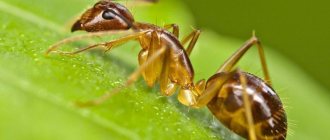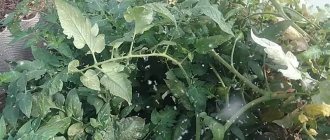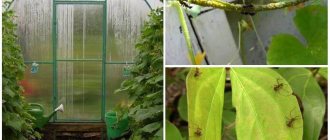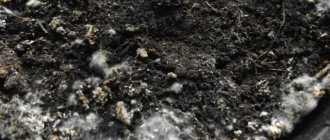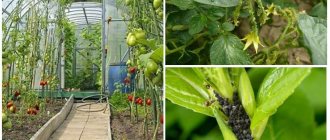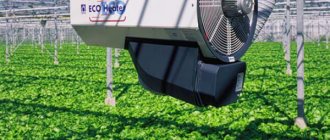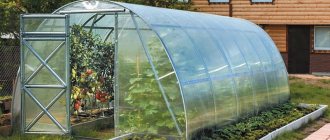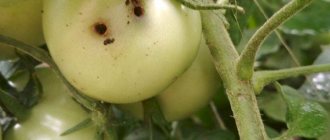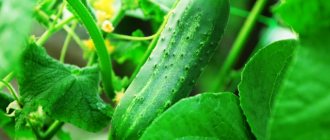It is known that various vegetables grow better in greenhouses and greenhouses, since the conditions there are much more suitable than in open ground, and some crops can even develop only in these conditions. In greenhouses, you can even grow tomatoes, cucumbers, peppers and many other vegetables all year round, but the conditions there are not ideal, since the temperature and humidity do not always correspond to the norm, and one of the reasons for this discrepancy is condensation accumulating inside the greenhouse.
Causes
Condensation in a polycarbonate greenhouse is formed due to natural reasons: moisture as a result of evaporation accumulates during the day, and in the evening and at night settles on the internal surfaces of the structure.
The presence of condensation can be determined by the characteristic drops of water on the walls and ceiling of the greenhouse. Condensation itself is relatively harmless to plants, but its presence signals increased humidity in the greenhouse, which can lead to various negative consequences, for example, diseases and the appearance of insect pests.
The main reasons for the formation of condensation in a greenhouse are as follows:
- Lack of ventilation;
- High planting density;
- Incorrect watering.
Condensation in the greenhouse can accumulate due to the lack of ventilation or its improper organization, since with irregular ventilation or its absence, the humidity in it will increase. As a rule, this phenomenon is observed in greenhouses and greenhouses without a sufficient number of vents with ventilation only through the door. This situation is typical mainly for structures with an arched roof, since it is technologically difficult to make vents on a curved roof surface, and therefore they are most often absent. At the same time, the presence of vents in the walls of the greenhouse reduces the ventilation effect.
The cause of condensation may be too high a planting density in a greenhouse or greenhouse, as well as if dead leaves are not removed in time. To create optimal humidity, it is recommended to maintain a norm of up to 3 plants per square meter.
Another common cause of condensation is improper watering. It is recommended to water the plants before noon, since in this case condensation will accumulate in less significant volumes. When watering in the evening, a greenhouse made of cellular polycarbonate does not have time to ventilate, and therefore more moisture accumulates in it. In addition, towards the end of the season, it is recommended to reduce the amount of watering, since the plants no longer need as much moisture.
Video about proper watering of tomatoes in a greenhouse
Additionally, watch video tips from Valery Kuzyuberdin, an experienced gardener, author of books on agricultural technology and host of the Do-It-Yourself Garden channel.
conclusions
In conclusion, I will summarize my conclusions and general recommendations on how to properly water tomatoes in a greenhouse.
- When watering, try to prevent water from getting on the leaf blades and stems of the plant.
- Water your plants in the morning or afternoon. Watering late in the evening and at noon is not advisable.
- Do not water with cold water - it puts the plants into a state of stupor.
- Try to water as evenly as possible.
- Immediately after watering, do not loosen the soil in the greenhouse in order to conserve moisture, prevent it from evaporating, and therefore prevent an increase in air humidity in the greenhouse.
- It is advisable to mulch the soil with humus in a 1 cm layer after watering.
- If possible, use drip irrigation - this is a modern and reliable method of watering that reduces the cost of manual labor to a minimum.
I wish you success in growing tomatoes, and let my tips on proper watering help you with this! ______________________________________________
Copying material is welcome provided there is an active link to the Antonov Garden website
How to reduce humidity
There are several ways to combat high humidity and, as a result, the appearance of condensation in a greenhouse. The most effective are the following:
- Mulching the soil;
- Covering the soil with film;
- Optimization of the ventilation system;
- Correct climate control scheme.
The simplest, but nevertheless giving the necessary effect of reducing humidity, is the procedure of soil mulching. To do this, you should place mulch in the soil, provided that it warms up well. These measures will reduce the rate of evaporation of moisture from the soil and thereby reduce air humidity.
Also, the evaporation of moisture from the soil can be slowed down with the help of plastic film - it is used to cover the ground. This method gives the greatest effect in hot weather. It is worth noting that it is better to use an opaque black film, which heats up well compared to colorless film, thereby preventing overheating of the soil.
For ventilation in a polycarbonate greenhouse to be effective, its design must be thought out. To do this, at the design stage, the required number of vents is calculated, evenly spaced at the top of the walls or roof of the greenhouse. The absence of vents is unacceptable, as this will automatically lead to an increase in humidity, the appearance of a large amount of condensation and, as a result, the threat of plant diseases and pest damage.
An important component to maintaining the inside of a greenhouse is the correct climate control system within it. To create the right climate inside a polycarbonate structure, various solutions are used: this can be the creation of a slope for polycarbonate sheets to drain condensate, the presence of drainage channels at the bottom of the greenhouse, a seal that will not allow the polycarbonate to be damaged, as well as holes in the frame profile to improve ventilation. These measures will not only combat high humidity, but also increase the service life of the coating.
In addition, you can use specially designed microclimate control schemes, but their cost is usually quite high, so not every gardener can afford it.
Condensation in a polycarbonate greenhouse
Modern greenhouses, both industrial and country houses, are finished with cellular polycarbonate. This material is highly durable and has a long service life. Complete tightness, which is achieved by using high-quality fastening and insulating materials, can lead to such an undesirable phenomenon as the formation of condensation in a polycarbonate greenhouse.
How to maintain humidity in a greenhouse
In creating the ideal climate inside a greenhouse for a country house, factors such as indoor moisture and ventilation play a major role. The quantity and quality of the crop that is planned to be harvested directly depends on how well these indicators are adjusted according to the rules.
Air humidity is the basis of plant life and depends on temperature conditions and the process of air exchange.
Additionally, the greenhouse can be equipped with a high-quality ventilation system that will maintain an optimal microclimate
For different types of crops, as already mentioned, their moisture indicators are required. That is why, as a rule, crops that are similar in terms of growing conditions are planted in one greenhouse structure. You can maintain the required humidity inside a polycarbonate greenhouse using a special air humidifier. Modern analogues of the device include a humidity regulator, which makes it possible to maintain the indicator at a stable level.
The ventilation system inside the greenhouse is no less important, as it maintains constant:
- Temperature level;
- Humidity level;
- Microclimate in a greenhouse.
Causes and consequences of condensation
The harm of condensation that appears on the ceiling and walls of the greenhouse should not be underestimated. Harmless small drops on the inner surface of the greenhouse can not only cause serious harm to the plants, but also destroy the entire crop.
So, the consequences of polycarbonate fogging can be as follows:
- decreased transparency of the surface, which leads to severe overheating;
- lighting of plants deteriorates;
- settling on the metal parts of the greenhouse, moisture can cause corrosion;
- a high concentration of steam in the air leads to the formation of large droplets, which can cause a short circuit in electrical appliances, which can lead to a fire;
- harmful bacteria appear and multiply in water;
- cloudy spots remain on the surface of the glazing, and mold may appear;
- moisture getting on greenhouse plants can cause various diseases;
- Increased air humidity complicates the process of evaporation of moisture from the soil, which can lead to rotting of fruits, leaves and roots.
Important
: The most popular greenhouse crops - cucumbers and tomatoes - do not tolerate high air humidity particularly well.
To get rid of the appearance of condensation in a polycarbonate greenhouse, you must first of all understand the causes of this phenomenon. Steam, which is formed during the life of plants and the evaporation of moisture from the soil, is a completely natural phenomenon for greenhouses. According to the laws of physics, warm steam rises up and, in contact with the colder surface of the structure's cladding, turns into water.
Why is this happening:
- The greenhouse is completely sealed and cannot cool down due to the lack of cold air flow. With doors and windows closed, condensation is inevitable.
- The temperature inside the greenhouse is significantly higher than the temperature of the air around it. This is a normal phenomenon, since the surrounding area is cooled by wind air currents and evaporation from the ground.
- The greenhouse was assembled in violation of technology. If the end parts of the plastic panels are sealed on both sides with sealing tape or tape, then there will be nowhere for moisture to escape from the honeycombs. Condensation in polycarbonate will appear until the sealing tape on the lower ends of the panel is replaced with a vapor-permeable membrane type.
- One of the reasons for the appearance of excessive amounts of moisture on the inner surface of greenhouses is a violation of the plant watering regime. This can be either watering during the hot season or exceeding the required amount of water when the soil becomes too wet.
Important detail
: In all cases, in order to avoid crop loss, it is necessary to take effective measures to eliminate the causes of condensation and eliminate it if it forms.
DIY air humidifier, How to make a humidifier (hand-make mist maker)
Reviews:
Bloody Man
writes: Where did you get the power supply from? Where can I get one? Does it come with Mist Maker?
Sergey Volchkov
writes: Good afternoon!
PyccTV
writes: tell me how many amperes the power supply is needed when connecting 3 evaporators?
Alexandr Dach
writes: how to connect the cooler?
Ichthyander 64
writes: did you measure the air humidity in the room using a hygrometer?? If so, what indicator? Thanks Antonich, it’s an interesting thing I want to use for dry-cured sausages; the humidity is needed at 75%, but where can I get it in the winter, and here in Siberia in the summer!!??
For soil, the optimal temperature is 14-25°C, but reducing it to 10°C will lead to phosphorus starvation of plants. And an increase to 25-28°C can, in turn, make it difficult for the roots to absorb moisture, which is why plants can wither from drought even in fairly moist soil.
When growing cucumbers in a greenhouse, temperature is more important. So, even before the first shoots appear, containers with crops are kept for a certain number of days at a temperature of +25+28°C. When the first greenery breaks through to the surface, the cover is removed, and the crops are installed in a well-lit place where the temperature is kept between +20+22°C. If we talk about night temperature, then in the first 3-5 days after the emergence of cucumber seedlings, seedlings should be grown at a temperature of +16+17°C to prevent unnecessary growth of the stem and elongation of seedlings, then the night temperature is within +19+20 °C.
Removing condensation
It is possible and necessary to deal with condensation. To do this, you can apply a number of technical solutions that relate to the installation of ventilation and heating devices in the greenhouse. Changing the plant watering regime can also significantly reduce the effect of vaporization.
Ventilation devices
To get rid of steam, which turns into water when it comes into contact with plastic, vents are used. It is not recommended to use doors for ventilation. Cold air from the lower layer can greatly harm greenhouse crops.
The rules for creating a ventilation system are as follows:
- Vents for air intake must be installed on the gables of greenhouses at a height of at least 1 meter. They can be mounted both on the wall and in the doors.
- To allow moist air to escape, transoms should be installed as close to the ceiling of the building as possible.
- To ensure a uniform microclimate in the room, it is recommended to install exhaust transoms every 2-3 meters.
Advice
: Windows can be made with manual or automatic opening mechanisms. If the greenhouse is located next to the house where the owner permanently lives, then there are sufficient devices for opening the windows manually. In cases where the greenhouse can remain unattended for one or several days, automatic ventilation systems are required.
These include the following devices:
- Forced ventilation system. They consist of thermal relays and electric fans. They can operate from an industrial electrical network or from batteries.
- Bimetallic devices. Using different coefficients of thermal expansion of two types of metal, a device was created that opens the window when heated and closes it when cooled.
- Hydraulic cylinders. The operation of such devices uses the property of liquids to change their volume when the temperature changes.
Ventilation can minimize the likelihood of condensation.
Heating greenhouses
The use of heaters of various types will ensure that condensation does not form. Considering that most greenhouse plants love moist soil and dry air, this will create good preconditions for obtaining a bountiful harvest. Various types of devices can be used for heating.
These include:
- oil radiators;
- electric heaters;
- heating cable that can be run along the floor and roof of the greenhouse;
- gas-burners;
- ultraviolet heaters;
- fan heaters;
- solid fuel stoves;
- water heating from the heating system of the house.
To maintain the optimal temperature, you can install a thermostat that will turn the devices on and off. It should be noted that electrical appliances are quite expensive to operate, and fuel-powered devices require constant monitoring.
Irrigation mode
Each greenhouse crop requires a certain amount of moisture for normal development. Both a lack of water and its excess can negatively affect the development of plants.
One of the factors that should be taken into account when planning irrigation is the thermal insulation qualities of cellular polycarbonate. It has very low thermal conductivity, which leads to a significant temperature difference between the inside and outside of the greenhouse.
Based on this, you should not water the plants before dark. The heat remaining in the greenhouse after daytime heating causes abundant evaporation of water from the soil. In combination with the evening and night coolness, this causes severe fogging of the internal surfaces of the greenhouse. To avoid excess moisture, you can leave the windows (but not the doors) slightly open overnight.
On a note
: The optimal time for watering plants in polycarbonate greenhouses is the morning. To do this, it is best to use warm, settled water. In the evening, watering can be done in small quantities, and only in cases where the day was very hot and the plants urgently need moisture.
It is strictly not recommended to water during the daytime in bright sunshine. This can cause overheating of the root system and death of plants. Light mulch has a good effect of reducing evaporation from the soil. If condensation forms in the greenhouse in the evening, it must be ventilated or warmed until it disappears. Cold drops and excessive dampness can harm plantings.
Greenhouse plantings require periodic maintenance. It is necessary to collect dead leaves from the ground and pull out weeds. Sick plants should be removed immediately to prevent infection of others. In heavily overgrown plants, it is advisable to remove side shoots and, in some cases, thin out. The recommended concentration is up to 3 bushes per 1 m².
Video about arranging automatic ventilation of a greenhouse
Hello, friends.
When I installed a polycarbonate greenhouse, I didn’t think that problems would appear where I didn’t expect them. I won’t talk about soil, seedlings, fertilizing, etc. now. I was almost ready for this (theoretically). But one morning I saw that the inside of the polycarbonate was covered with small droplets - condensation! Well, you never know - the night was cold or something else... But the next day it was the same, and the next. But dampness in a greenhouse is bad! I knew this well. But gradually I found out where condensation in a greenhouse comes from, what its danger is and how to deal with this phenomenon.
At night, the temperature outside and in the greenhouse gradually levels out, and by morning it becomes almost the same. But the sun appears, and the air inside the greenhouse begins to quickly warm up. But the outer surface of the polycarbonate (or film) is still cold, and the plants themselves and the soil have not yet had time to warm up. The moisture contained in the air (and it is always there) begins to accumulate on the surface, like on the lid of a pan when water boils. There are no other reasons for the appearance of condensation other than temperature changes - the law of physics. Of course, its quantity depends on the level of humidity, but that is another question.
Water supply
For timely irrigation of plants, a prudent owner must ensure that there is a constant water supply . And since most areas of a particular area experience serious problems with a continuous supply of water from centralized systems, the best option in this case would be to install a water reservoir , which will allow you to stock up on water in the greenhouse for future use.
In any case, the presence of a container a drip irrigation system .
How to install a barrel for irrigation in a greenhouse? The water tank can be installed both outside and inside the greenhouse. Most often, containers with a volume of 150-200 liters . When installing a water tank outside the room, it is usually placed on a hill at a distance of 1.2-1.5 meters from the ground, not far from the greenhouse itself.
The location of the tank inside the structure has some positive features:
- the temperature of the water in the container coincides with the temperature in the room (water for irrigation in the greenhouse must be warm );
- a reservoir heated during the day will help maintain the temperature in the greenhouse at night, and will also serve as a source of providing the necessary humidity .
The disadvantage of this method is that the container installed inside will take up space in the garden bed , so this option is more suitable for spacious buildings.
Automatic windows are not a solution
Nowadays, various options for automatic ventilators for greenhouses are offered. You can install openers for doors and standard vents, or you can install separately - in the roof or in the side - vents with automatic opening. These devices are undoubtedly useful. They make the work easier and help avoid steaming the plants if for some reason you forgot or were unable to open the greenhouse on time. But automatic openers or vents won’t help much with condensation. They are designed so that they open at a temperature of 18-24 °C. And by this time, condensation has already formed and will safely settle in droplets on the surface of the greenhouse.
What are the signs of insufficient humidity?
Dry air can cause yellowing of the edges of the leaves, the appearance of spots on them, and the falling of buds and flowers. Low humidity will primarily affect the young leaves of the plant: the upper part and those that are far from the pot. The leaves usually dry out at the tip. If not only young leaves dry out or the damage affects, for example, only one shoot, then the reason is not low humidity. This could be sunburn, hypothermia, infection or parasites. To understand what's wrong, carefully examine the plant.
Harm from condensation
Condensation on polycarbonate or film itself is not a tragedy. But it, or rather, droplets of water, will sooner or later fall down - onto the plants. Is that bad. Tomatoes, for example, really don’t like it when the leaves are wet. Cucumbers are not so picky, but for them and for other plants, unplanned moisture still poses a danger: it is in a humid environment that various pathogens live and reproduce - late blight, root rot, powdery mildew, spider mites, mold.
In a polycarbonate greenhouse, moisture tends to roll down rather than drip onto the surface. In film greenhouses, droplets fall directly onto the plants. But I also discovered another problem in polycarbonate greenhouses. When moisture rolls down, it hits the lower foundation of the greenhouse. If it is wooden, then such a permanent bath will not be beneficial. Other wooden parts also suffer. For example, fencing the beds (it had to be made of slate). And I also noticed: the edges of the beds are always damper than the middle. I don't like this uneven hydration either.
Thermo-hygrostat on Arduino.
Reviews:
TheTHILIM
writes: At the request of the workers, I sketched out a connection diagram, download from here
Alexander Kosenkin
writes: Please draw a diagram
Denis Matusevich
writes: Still, the serviceability of the temperature sensor has not been checked (if it shows -273, how long will the heaters work?), it is necessary to implement control of the temperature of the heater itself, in the summer the greenhouse often overheats on the contrary, and it is necessary to remove heat from the greenhouse.
NIKOLAICH
writes: Thank you...
Denis Matusevich
writes: The idea is normal, but this is not how automation is done.
How to get rid of condensation
- The best way to get rid of condensation and excess humidity is ventilation. Try to open doors and windows as early as possible. And if possible, do not close them at all at night.
- Do not create conditions for increased humidity yourself. It's better to water in the morning! Then the water that is not absorbed into the soil will evaporate and disappear within a day.
- - a way to reduce humidity in a greenhouse. Water after watering under mulch will not “spontaneously” evaporate and accumulate in the air.
- Even if some of the moisture (condensation) gets on the plants, it will not cause much harm if the plants are free, they are well ventilated and dry. So stop thickening your plantings!
- Try to avoid temperature changes in the greenhouse - this is both the cause of condensation and the cause of plant disease.
Good luck in the garden!
Most modern greenhouses, both industrial and country houses, are finished with polycarbonate sheets. This material is famous for its high strength, good light transmittance and fairly long service life.
The use of modern, high-quality fastening and insulation materials leads to complete sealing of the greenhouse. In addition to a lot of positive aspects, this can also lead to such an undesirable phenomenon as condensation.
What temperature and humidity should be in the greenhouse
In mid-summer, the temperature in the greenhouse can rise to 40-45°C. Of course, this is an unacceptable indicator, because pollen becomes sterile already at 30-35°C. How many degrees should it be in the greenhouse for the plants to feel comfortable?
The answer to this question, first of all, depends on what exactly you have planted in your shelter. Different crops require different levels of temperature and humidity for trouble-free development and active fruiting. Let us mention the main ones:
- cucumbers prefer an air temperature of 25-28°C during the day and 18-21°C at night, soil temperature - 22-24°C, air humidity - 75-85%;
- tomatoes grow and bear fruit better at an air temperature of 20-22°C during the day, 18°C at night, soil temperature 20-22°C, air humidity 60-70%;
- peppers feel comfortable at an air temperature of 25-28°C during the day and 20-23°C at night, and air humidity of 66-75%;
- Eggplants like it when the air warms up to 25-28°C during the day, and cools down to no more than 20°C at night, while they prefer air humidity no higher than 50-60% (with high soil moisture).
As you can see, it is the requirements of the plants themselves that are the main contraindication to the joint cultivation of some crops. Yes, you can plant them all in one greenhouse and even get some harvest, but it will be much less than with mono-plantings.
Reasons for condensation in a greenhouse
Do not underestimate the harm of condensation that appears on the walls and roof of the greenhouse. It would seem that harmless droplets on the walls of the greenhouse cannot harm the crops being grown, but this is far from the case. These droplets can destroy the entire crop.
Possible consequences from exposure to condensation:
- a significant decrease in the transparency of the greenhouse, which can lead to its overheating;
- deterioration of lighting;
- possible corrosion of metal parts of the greenhouse;
- too high a concentration of moisture in the air can lead to short circuits in electrical appliances;
- water is an ideal environment for the proliferation of harmful bacteria;
- cloudy spots remain on the walls of the greenhouse, which can lead to the formation of mold;
- moisture getting on plants can cause various kinds of diseases;
- obstructed process of evaporation of moisture from the soil, leading to plant rotting.
Before you get rid of condensation in a greenhouse, you should understand the reasons for its occurrence. A natural phenomenon for a greenhouse is steam, which is formed during the life of plants. According to the laws of physics, warm steam rises upward, where it comes into contact with the cold surface of the greenhouse. At this moment it turns into water and remains on the walls of the greenhouse.
Why is this happening:
- Constantly closing windows and doors in the greenhouse leads to its sealing.
- The air temperature inside the greenhouse is always significantly higher than the temperature outside.
- Violation of greenhouse assembly technology. If the end parts of the greenhouse cladding were taped on both sides, then there would simply be nowhere for the condensation to evaporate. In this case, you should replace the sealing tape with a vapor-permeable membrane.
- Violation of the watering regime. Watering in hot weather or watering too much can lead to condensation.
Removing condensation
It is possible and necessary to combat the formation of condensation. To do this, you can resort to technical assistance, such as devices for ventilating the greenhouse and heating it. Changing the irrigation regime can significantly reduce the risk of condensation.
How to lower the temperature in a greenhouse
Any experienced gardener knows: when you leave the house in the morning, open the door to the greenhouse wide open. However, in the July heat and calm, this will not be enough to lower the temperature in the greenhouse, and the plants will still suffer. There are more effective, although more labor-intensive, methods.
Greenhouse painting
The most common method in the post-Soviet space is to paint the greenhouse with homemade paint based on lime, chalk or clay. True, it only works on greenhouses made of polycarbonate and glass, but it is not feasible with film shelters.
In order to minimize sunlight reaching the plants and heating the air in the greenhouse, its roof and upper parts of the walls are thickly whitened, turning them almost opaque.
If you paint the outside of the greenhouse, the first rain will wash away all your efforts, and over the summer you will enrich the soil around with a huge amount of unplanned substances. Therefore, it is better to whiten the carbonate or glass from the inside, but do it before planting the seedlings, so as not to pour it on or trample it. And in the fall, carefully wash off the coating during seasonal treatment of the greenhouse.
- How to prepare a greenhouse for winter: useful tips for summer residents
The summer season does not end after the harvest. There is still a lot to be done, including cleaning up the greenhouse.
Artificial shelters for greenhouses
Another option for protection from the sun is to create shelters on the south and east sides or from above. As a covering material, you can use either ordinary dense spunbond or burlap, or special protective nets with a partial reflective effect. The nets look neater and are sold together with fasteners; moreover, they are designed for greenhouses of standard sizes, but from scrap materials you can assemble a structure of any size and shape.
If there is excess light only on one side, then you can also build a light-protective screen that will be disassembled during the off-season.
Canopy plants for shading a greenhouse
Another unusual but effective method is to plant plants with lush greenery next to the walls of greenhouses. Any vines or bushes used to create hedges are ideal. True, this method also has a nuance - such a wall will absorb light even in a cold and rainy summer, so it can become a serious competitor for greenhouse crops.
- All about hedges - choosing plants, pruning, care
Do you want to plant a hedge on your property, but don’t know where to start? We'll tell you!
If you have a spacious greenhouse and there is no need to fight for every meter of insulated area, you can plant fast-growing vines on the inside of the structure. Their foliage forms a green canopy inside and will provide shade for your delicate pets.
Ventilation of the greenhouse
The minimum that you simply must take into account when choosing a greenhouse is the presence of at least a couple of windows for through ventilation. In modern models, parts of the roof are raised, parts of the walls are removed, and temperature control and automatic ventilation sensors are installed.
However, if you don’t think it’s rational to spend money on these delights, then at least regularly open the windows in the greenhouse.
Installing fans in a greenhouse
If there is only one window in the greenhouse and it is not possible to create a draft naturally, a regular fan will come to your aid. It can be installed either at ground level or on top of the back wall of the greenhouse. The same option works if you have a large greenhouse complex.
True, this method has a couple of significant drawbacks. Firstly, you will spend a lot of money on paying for additional electricity, and secondly, you will need a large extension cord that can be pulled into the greenhouse from the nearest power source.
Water containers
Containers with water of different sizes allow you to not only cool the greenhouse in the heat, but also soften daily temperature changes. Most often, large-volume plastic or metal barrels are used for this, but plastic bottles placed between rows and directly on the beds are also suitable. During the day, the water in the containers will heat up, and at night it will gradually release heat, warming the plants.
In barrels installed in a greenhouse, you can not only settle water for irrigation, but also prepare fertilizers from grass or keep dissolved droppings before fertilizing.
Ventilation devices
The simplest device for getting rid of steam, which turns into water in contact with the cold walls of the greenhouse, is. It is not recommended to use doors to ventilate greenhouses, as cold air flowing through the bottom of the greenhouse can harm the plants.
- Vents for air supply should be installed on the gables of the structure. The height must be at least 1 meter from the floor. Windows can be installed both on the wall and on the door of the greenhouse.
- In order for moist air to escape from the greenhouse, transoms should be installed closer to the ceiling of the greenhouse.
- To maintain an ideal microclimate inside the greenhouse, it is recommended to install transoms every 2-3 meters.
Vents in greenhouses can be made with either manual or automatic opening. If you live next to a greenhouse and it is not difficult for you to ventilate the greenhouse manually, then you can safely install the simplest manual vents.
If you don’t want to bother with this matter, then you should resort to automating this process. Such equipment will cost much more than a regular window, but with its help you will save your time, and you will also be able to safely leave the greenhouse unattended for several days.
The automatic ventilation system includes the following devices:
- Forced ventilation system. Such a system, powered by an electrical network, consists of a thermal relay and electric fans that turn on when a set temperature is reached.
- Bimetallic devices. In this case, the coefficient of thermal expansion of two types of metal is used. This device opens the window when heated, and closes it when properly cooled.
- Hydraulic cylinders. The operating principle of this device is to use the properties of a liquid to change its volume when the temperature changes.
Regular ventilation reduces the risk of condensation to a minimum.
Mulching with sawdust
Wood waste is an excellent material for mulch. You can use sawdust from fruit trees. Remember that softwood sawdust is too saturated with resins and phytoncides, so it’s better not to take risks, because this can harm the plants. For the same reason, you should avoid nut sawdust.
It is convenient to mulch rows with sown seeds using small wood waste. Larger sawdust goes under the planted seedlings. One nuance is important here: when planting small-seeded crops, the layer of sawdust should not be thick, literally a couple of centimeters, and under seedlings it can be laid up to 7 cm thick.
Greenhouse heating
The use of various heating devices will help to ensure that condensation does not appear in the greenhouse. Most plants prefer moist soil and dry air, so using air heaters will have a positive effect on the microclimate inside the greenhouse.
The following devices can be used as heaters:
- oil radiator;
- electric heater;
- heating cable;
- ultraviolet heater;
- fan heater;
- solid fuel stove;
- water heating coming from the house heating system.
In order for electric heating devices to work autonomously, you can install a thermal relay that will turn them on when the temperature you set is reached. The disadvantage of this heating method is the high cost of electricity.
How to measure relative humidity?
Using a special measuring device - a hygrometer. There are different types of hygrometers: some measure relative humidity, others measure absolute humidity, and others measure dew point. We are only interested in the first.
For gardening needs, there are very convenient electronic hygrometers, which are almost always combined with a thermometer (temperature is another important indicator that should be closely monitored throughout the growing process). There are simpler options, and there are more expensive ones, because they are equipped with a remote probe for easy temperature control inside and outside the greenhouse.
Irrigation mode
Each crop grown in a greenhouse requires a certain amount of moisture. Lack or excess of water negatively affects the development of the plant.
When planning irrigation, the thermal insulation properties of the greenhouse walls should be taken into account. Polycarbonate has low thermal conductivity, and this leads to the formation of a significant temperature difference inside and outside the greenhouse.
Based on the above, we can conclude that watering before dark is not advisable. The heat that remains in the greenhouse after daytime heating causes strong evaporation of moisture from the soil. Together with the coolness of the night, this causes inevitable fogging of the greenhouse walls. If you water your plants in the evening, leave the greenhouse windows open.
The best time for tomatoes and other plants is early morning. It is best to water the crops with warm, settled water. It is strictly forbidden to water plants during the day, in hot weather. Such watering can cause overheating of the plant, and even its death.
Greenhouse crops require maintenance. It is necessary to pull through weeds and collect fallen leaves. Diseased plants should be removed immediately, otherwise they may infect neighboring crops. Thinning should be carried out on heavily overgrown plants. The optimal concentration is up to 3 plants per 1 square meter.
What is mulch
Mulching is the addition of a layer of decomposing organic matter to a greenhouse or garden to greatly improve the health of plants and reduce maintenance. With its nutrient-rich, moisture-absorbing layer of decaying forest leaves teeming with fungi, microbes and insects, mulch can serve as a nutrient bank that slowly releases its nutrients, making them available to plants.
Soil and greenhouse cultivation
Planting cucumbers in a greenhouse begins with proper soil treatment. It is necessary to disinfect the greenhouse frame and the soil itself. Treatment is carried out using solutions of bleach (in autumn) and potassium permanganate (in spring).
Greenhouses with flowering cucumber seedlings must be ventilated frequently, and if possible, bees must be allowed inside the greenhouse to pollinate the cucumber inflorescences. Proper ventilation in a greenhouse is the key to a high yield of cucumbers. Drafts should not be allowed to form while growing cucumbers - this will negatively affect the yield (drafts deprive cucumber sprouts of the necessary carbon dioxide and help reduce humidity).
It is necessary to apply organic fertilizers to the roots of cucumbers - as a result of the saturation of the roots with organic matter, the formation of female inflorescences accelerates and the yield increases.
Plastic jars 8-20 liters: for long periods of absence
So, if you need to leave and there is no good neighbor, then find or buy plastic water bottles. Volume, the more, the better. Clean water can be used in the household, and technical water can be poured into bottles for irrigation. Close the bottles with lids. And carefully, using an ordinary nail (the nail is heated over a fire and pierced into bottles) or a drill, make a couple of holes at a height of 2-5 cm from the bottom (depending on the size of the bottle). Make the holes so that one stream flows to one plant, the second to the neighboring one. Place the bottle between the plants, slightly deeper into the soil. Hooray! This watering will last you at least a week.
It is better to make small holes, so the water will last longer
You can prepare the entire irrigation system in advance, but start it all at once right before you leave. To do this, do not remove the nails from the holes before you are ready to leave the dacha. We recommend! Before leaving, it is good to water the entire greenhouse.
If you only have 5-8 liter bottles and you need to leave the greenhouse for a long time, then make one hole on the side and put 1-2 jars per plant. Banks are CLOSED! Place jars of water next to the main trunk, hole facing down.
Lighting and watering in a greenhouse, plant nutrition, photosynthesis | GREEN BLOG
We continue the conversation on the topic of greenhouse vegetable growing. What is the degree of dependence of the volume of the future vegetable harvest on the lighting of greenhouses, the composition of the air inside closed ground structures, the quality of watering plants, and the organization of nutrition for plants in greenhouses.
Greenhouse lighting
Greenhouse lighting must be sufficient for light nutrition of plants - the process of absorbing solar energy and converting it into biological mass (stems, leaves, flowers, fruits, roots), that is, everything that a person uses for food. We’ll talk about how this happens, how plants conserve solar energy, later. First, you need to understand the optical properties of materials (film, glass, polycarbonate) used to cover cultivation structures (greenhouses, greenhouses).
Film greenhouse
In terms of its optical qualities, the film does not differ from glass, which has long been used as traditional materials in the manufacture of greenhouses. In terms of ultraviolet permeability, it is significantly superior to glass, while at the same time it has a high light-scattering ability, therefore reducing the influx of direct solar radiation. The film has high transparency for far infrared radiation, that is, thermal radiation. This quality causes significant heat loss at night and intense heating of the greenhouse air during the day.
Polyethylene film is the most common material for covering greenhouses, having the shortest service life due to the effects of frost and sunlight. Stabilized film contains special substances - stabilizers, which protect the material from sunlight, thereby extending its service life. The reinforced film has a mesh layer of polypropylene threads to increase its mechanical strength; in addition, it is less susceptible to the destructive effects of sunlight; unlike glass and polycarbonate, it can protect plants from direct exposure to the sun, causing burns (plants will not “burn”). Ethylene vinyl acetate film is not inferior in quality to reinforced and stabilized films, has good thermal insulation, and high light transmittance (up to 98%). Compared to polyethylene film, it can withstand frosts down to -40˚C, due to its elasticity it is resistant to mechanical stress, special substances added to the mass can reduce the formation of condensation and smudges (water flows down the film), so the greenhouse is better illuminated by sunlight.
Glass greenhouse
Sunlight reaching the Earth consists of 3% ultraviolet rays and 55% infrared radiation. When falling on glass, light is partially reflected, partially absorbed by the glass, and partially passes through it. The degree of reflected, absorbed and transmitted light depends on the type of glass (from M1 to M8). High-quality glass allows ultraviolet radiation to pass through, so in cars or houses with window frames with double-glazed windows from companies with a good reputation (if reflective glass, that is, solar control glass with a special coating, is not installed), you can get sunburned.
A glass greenhouse does not transmit ultraviolet radiation, which is so necessary for plant growth and for pollination by bees, bumblebees and other insects. In addition, glass does not have a light filter, that is, it does not scatter light, the sun's rays passing through it practically do not change their direction relative to the plane, as a result, the light reaches only the upper part of the plants, and plants in closed ground are not fully illuminated. A material such as glass has high thermal conductivity, which causes burns to plants. Its light transmittance coefficient is 90% (single polyethylene has a coefficient of 89%–93%, double polyethylene 79%–87%).
